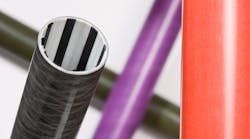Carbon Fiber or Fiberglass: Choosing the Correct Composite
You wouldn’t attempt to delicately manicure a bonsai tree with a chainsaw, even if it would be entertaining to watch. This may seem obvious, but there are many fields where selecting the right tool is a vital ingredient to success.
In the composites industry, customers often request carbon fiber when in fact fiberglass is a better-suited high-performance material for their needs.
Carbon fiber is often hailed as the material of the future. When people think of carbon fiber, they’re likely to envision slick sports cars with doors that open vertically or, if they are industry-focused, wind turbine blades longer than previously imaginable.
For most composite producers, carbon fiber is the material that gets customers and their design engineers interested in composite—before they realize that other composites such as fiberglass are better suited to their project.
Sports cars, road bikes, and professional tennis rackets are all extensively made using carbon fiber. This is because these applications require a low density and high ultimate tensile strength material to maximize weight advantages. However, this doesn’t mean that carbon fiber is perfect for every application.
Raising the Glass
In many cases when clients are looking for carbon fiber, the material that better suits their needs is fiberglass. In fact, it could be said that fiberglass was the first-ever high-performance material, with its conception dating back to before the Second World War. Fiberglass has proven its usefulness over and over, from use in door or window frame profiles to telescoping poles, in automotive applications to rail joints and telecommunications radomes.
If you have the impression that fiberglass is reserved for making rowboats, it may be time to take another look at what else it can achieve.
Fiberglass has a very good ultimate tensile strength, higher than most metals. It’s a great insulator, with a very low coefficient of thermal expansion, and it is corrosion and weather resistant.
For example, the ITER fusion reactor, a tokamak-style fusion reactor being developed by 35 collaborating nations, uses fiberglass composite pre-compression rings (PCR) to hold the reactor together.
The ITER fusion reactor uses the PCRs to absorb the deformation and fatigue from magnets that hold the plasma, which is heated to 150 million degrees Celsius, in place. Fiberglass was selected for the PCRs because of the material’s specific high-performance mechanical properties.
Fiberglass has withstood the test of time. Since its early use in World War II, the material has yet to be replaced with a better alternative. This is largely due to the material’s mechanical properties combined with its competitive cost and design flexibility.
Tailor-Made
With composites, it is also important to note that the choice is not binary. At Exel Composites, we offer a range of pultruded and pull-wound composite solutions. We manufacture many carbon fiber products along with fiberglass and hybrid combinations, where we use both carbon and glass fibers.
Deciding on the best material choice requires a clear understanding of the desired application and product specifications, and we first work with customers to develop a mutual understanding.
Based on this understanding, your composites supplier should use their materials science expertise to design your ideal composite product. This discussion should include costs, particularly as raw carbon fiber materials come at a higher cost point than fiberglass.
Tailoring a composite can range from a specific mix of fibers to giving certain properties, to managing the fiber alignment and resin formulation.
For example, a fiberglass tube could require extra reinforcements along one side of the geometry. In this case, carbon fibers could be strategically incorporated into the tube along with the fiberglass at the point of manufacturing to create a strong hybrid structure that meets design requirements while considering cost optimization.
Having the correct tool at your disposal is important whether you are trying to prune a bonsai tree or upgrade a piece of infrastructure. While it may seem more appealing to use a chainsaw, or carbon fiber, lower-key choices can sometimes be the better option for the task at hand.











